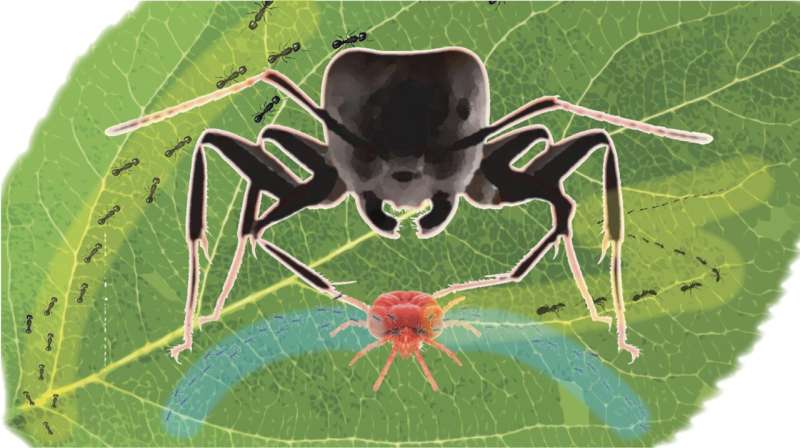Ants consume various arthropod species, implying that spider mites may not be the only species of prey that avoid ant trace chemicals. Credit: KyotoU/Global Comms
Ants may not urinate to mark their territory as dogs do, but the behavior of spider mites might suggest otherwise. Under significant pressure from ants, mites have to choose between safety and risk: staying out of ant territory to avoid predation or venturing into it to find food.
Now, a team of researchers at Kyoto University have studied two species of spider mites that avoid trace chemicals left by ants within their territories. Tetranychus kanzawai and T urticae both avoid food plant leaves with active traces of two ant species.
"These mites also avoided walking along ant-traveled food plant stems as a way to evade their natural predators," says lead author Shuichi Yano. Because edible leaves are connected by stems, such a defensive move denies mites access to significant food resources.
The chemicals ants leave are information intended for nestmate and non-nestmate ants, and mites have developed an ability to detect active traces as hints of danger. Other herbivorous insects have also been reported to avoid plants inhabited by ants.
"The effectiveness of such non-consumptive effects of predators on prey are sometimes comparable to that of direct consumption," notes the author.
The team conducted dual-choice experiments using kidney bean leaves and stems arranged side by side to examine how mites traveled along tainted parts of branches.
"Surprisingly, spider mites avoided traces of both enemy and non-enemy ant species, suggesting that these cognitively limited mites have not developed species-specific avoidance abilities against all predators," adds Yano.
Ants consume various arthropod species, implying that spider mites may not be the only species of prey that avoid ant trace chemicals.
"Using this knowledge, pesticides that are based on ant trace chemicals could possibly complement if not replace synthetic ones."
The research was published in Experimental and Applied Acarology.
More information: Shuichi Yano et al, Avoidance of ant chemical traces by spider mites and its interpretation, Experimental and Applied Acarology (2022). DOI: 10.1007/s10493-022-00752-5
Provided by Kyoto University























